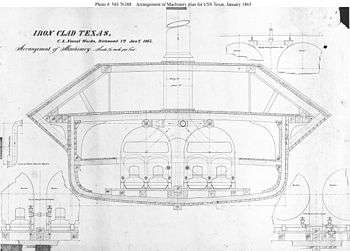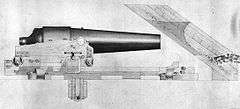CSS Texas (1865)
CSS Texas was the third and last Columbia-class (or Tennessee-class according to some sources[1]) casemate ironclad built for the Confederate Navy during the American Civil War. Not begun until 1864 and intended to become part of the James River Squadron, she saw no action before being captured by Union forces while still fitting out. CSS Texas was reputed to have been one of the very best constructed Confederate ironclads,[2] second only to CSS Mississippi.[3]
 One of the few pictures of CSS Texas in existence; a cross-section drawing through the boiler area. | |
| History | |
|---|---|
| Name: | Texas |
| Namesake: | State of Texas |
| Launched: | January 1865 |
| Captured: | 4 April 1865 |
| Fate: | sold, 15 October 1867 |
| General characteristics | |
| Class and type: | Columbia-class casemate ironclad |
| Length: | 217 ft (66.1 m) |
| Beam: | 48.5 ft (14.8 m) |
| Draft: | 13.5 ft (4.1 m) |
| Propulsion: | steam |
| Complement: | 50 officers and men |
| Armament: | four pivots, two broadside guns |
History
Designed by John L. Porter, the Confederacy's chief ironclad designer, CSS Texas belonged to an 1863/64 class of three, with CSS Tennessee (1863) – also referred to as the CSS Tennessee II – and CSS Columbia slated as class sisters. However of these three, only Tennessee was completed and commissioned, proving her mettle in the Battle of Mobile Bay,[1] whereas Columbia was launched but incapacitated while being completed, never to see any operational duty in the war, despite being captured, repaired and appraised by the Union Navy.
The keel for CSS Texas was laid down at Rocketts Naval Yard, just outside Richmond, Virginia. She was launched in mid-January 1865, almost at exactly the same time unfinished sister Columbia was crippled beyond salvation.[4] At the time of Robert E. Lee's evacuation of Richmond on 3 April 1865, she was left unfinished but intact at the Richmond Navy Yard, one of only two vessels (the other one being the small iron-hulled gunboat CSS Beaufort) which escaped destruction by the retreating Confederate forces,[5] though attempts were made to set her ablaze.[6] Captured when the city fell the following day, both ironclad and gunboat were appropriated "for use in the Navy", as per Union Admiral David D. Porter (not related to the Texas designer).[5] In his official report of April 12, 1865, Porter mentioned that he was informed that the engines and parts of her amor were not yet installed, but resided undamaged, but completed in the warehouses of the Richmond naval yard. He subsequently ordered all to be taken for transport to the Norfolk Naval Shipyard, along with the ship they were intended for. This task was started on 3 May 1864 and completed the following day, when Texas was towed by three tugboats downstream, accompanied by the Union ironclad USS Sangamon (1862), commanded by Lieutenant Commander R. Chandler who was given the overall assignment.[5]
As the war was winding down and unlike her likewise captured sister Tennessee, she was ultimately not commissioned into the Union Navy and saw no active service save for a trial run on 22 June 1865 with her engines apparently installed, the one and only time Texas was known to have sailed under her own power.[7] Texas was eventually laid up at the Norfolk yard until 15 October 1867 when she was sold at auction for scrapping to J. N. Leonard & Co.[8] of New Haven, Connecticut, having originally cost $218,068 to construct.[7][2]
Design
The casemate of Texas was roughly octagonal, rather than being a sloped, rectangular, armored box, as on earlier Confederate ironclads and including her class sisters; during construction, it was shortened and reshaped due to critical war materials shortages, also accounting for the substantially reduced projected crew count in comparison to that of class sister CSS Tennessee II. It fitted snugly around her eight gunport positions, six of which were to be used with two pivot cannons, each firing from three forward or aft positions.

Details of her armament are sketchy, but her sister Tennessee II, carried four 6.4-inch (163 mm) Brooke rifles, two 7.0-inch (178 mm) Brooke rifles, and a bolted-on spar torpedo fitted to her bow. Tennessee II's armor was three layers of 2-inch (51 mm) iron plate, and instead of being bolted to her deck, the pilot house formed a seamless extension of her sloped side-armor. Tennessee II's top speed was about 5 knots (9.3 km/h; 5.8 mph), according to some sources, and her crew numbered about 133 sailors. However, it is unclear how closely Texas would have resembled her sister had she been completed, if at all, considering the material shortages Texas had to contend with during its construction, particularly for its casemate.
Other sources gave Texas a (projected) top speed of about 10 knots (19 km/h; 12 mph), and these note that both Tennessee II and Texas differed from each other in their final details due to a lack of available materials, notably the iron plate for her armor; her cannons and engines were also different. During her construction design improvements were incorporated from lessons learned in combat with the U.S. Navy.[6]
Particulars on her dimensions and propulsion, recorded by her Union captors, were later included as a statistical summary in the "Official Records of the Union and Confederate Navies in the War of the Rebellion". In it, it was stated that she measured 217 feet in length, 48.6 feet abeam, and was designed to draw 13 feet of water and 13.6 feet when loaded. A twin-engined vessel, each driving a separate propellor, she was powered by two 22(L)×8.4(W)×9.1(H) feet boilers, heated by a 7(L)×3.6(W) feet furnace with a grate surface area of 96.8 square feet. Recorded is also an appraisal of an inspecting Union officer, who deemed Texas as "(...) one of the best and most valuable hulls built by the Rebels". It was only in this summary that the June 22 trial run was mentioned.[7]
Popular culture
CSS Texas is featured prominently in the 2005 film Sahara, based on the best-selling book of the same name by Clive Cussler. In both movie and novel, a team of treasure hunters search for what was by the late 20th century presumed a mythical Confederate Civil War ironclad ship, carrying an equally mythical hoard of gold bullion – therefore constituting another take on the so-called "Confederate gold" myth. In the fictionalized movie version of historical events and unlike its historical counterpart, CSS Texas, close to completion and under the command of Captain Mason Tombs, made it out of Richmond just before the fall of the city, battling itself through the Union blockade of the James River before disappearing altogether, and carrying what remained of the Confederate war treasury in gold bullion, the hoard the treasure hunters are after. The ship, its contents and the mortal remains of its crew, they having succumbed to a tropical disease, are a century later discovered buried in an old, dried up riverbed of the Niger River, deep in western Africa (thereby making the implausible assumption that the ironclad had somehow managed to cross the Atlantic Ocean on its own accord). The adventurers manage to reactivate the armament of Texas in order to battle off an African warlord and his troops, succeeding in killing him, even though the armor of Texas is riddled as it is no match for the modern armor piercing ordnance. Ship and contents are at the end of the movie remanded in the custody of the Smithsonian Institution, but not before the treasure hunters have absconded with the hoard.
In the actual book by Clive Cussler, the Texas is powered by engines that enable her to make 14 knots, and armed with four guns, two Blakely 100-pounder guns and two 9-inch, 68-pounder guns.
Two recreations of CSS Texas were constructed for the movie, a scale model and full sized exterior and interior sets, however their outer appearances did not correspond with what is known about the historical vessel; instead the vessel as represented in the movie resembled in outer appearance an amalgam of the original CSS Virginia (of the Battle of Hampton Roads fame and Porter's original casemate ironclad (co-)design, on which he based his two basic, 150 ft and 180 ft, standard designs, Columbia-class being an enlarged variant of the latter) and the CSS Tennessee (the famed class sister), which were both endowed with substantially larger and differently shaped casemates, for reasons already explored above in the latter case.[9]
References
- Konstam, 2001, p. 8
- Gibbons, 1989, p. 23
- Melton, 1968, p. 249
- Gibbons, 1989, pp. 34, 52
- Official Records of the Union and Confederate Navies in the War of the Rebellion, Series I, Vol. 12, pp. 98, 101 and 115, 1901
- Konstam, 2001, p. 16
- Official Records of the Union and Confederate Navies in the War of the Rebellion, Series II, Vol. 1, p. 269, 1921
- Price & Lee Directory (1899)
- Gibbons, 1989, pp. 22-23, 34-35, 44-45
Sources
- Bisbee, Saxon T. (2018). Engines of Rebellion: Confederate Ironclads and Steam Engineering in the American Civil War. Tuscaloosa, Alabama: University of Alabama Press. ISBN 978-0-81731-986-1.
- Canney, Donald L. (1993). The Old Steam Navy: The Ironclads, 1842–1885. 2. Annapolis, Maryland: Naval Institute Press. ISBN 0-87021-586-8.
- Chesneau, Roger; Kolesnik, Eugene M., eds. (1979). Conway's All the World's Fighting Ships 1860-1905. Greenwich, UK: Conway Maritime Press. ISBN 0-8317-0302-4.
- Gibbons, Tony (1989). Warships and Naval Battles of the US Civil War. Limpsfield, UK: Dragon's World Publishing. ISBN 1-85028-094-0.
- Melton, Maurice (1968). The Confederate Ironclads. South Brunswick, New York: Thomas Yoseloff Ltd.
- Konstam, Angus (2001). Confederate Ironclad 1861-65. Wellingborough, UK: Osprey Publishing. ISBN 1-84176-307-1.
- Silverstone, Paul H. (2006). Civil War Navies 1855–1883. The U.S. Navy Warship Series. New York: Routledge. ISBN 0-415-97870-X.
- Still, William N., Jr. (1985). Iron Afloat: The Story of the Confederate Armorclads (Reprint of the 1971 ed.). Columbia, South Carolina: University of South Carolina Press. ISBN 0-87249-454-3.
External links
- Ships of the Confederate States: CSS Texas (1865) – Webpage from the Naval Historical Center
- The Evolution of the Ironclad CSS Texas – Webpage from Civil War Talk